check engine YAMAHA XMAX 400 2014 Owners Manual
[x] Cancel search | Manufacturer: YAMAHA, Model Year: 2014, Model line: XMAX 400, Model: YAMAHA XMAX 400 2014Pages: 92, PDF Size: 7.3 MB
Page 6 of 92

TABLE OF CONTENTSSAFETY INFORMATION.................. 1-1
Further safe-riding points ............... 1-5
DESCRIPTION.................................. 2-1
Left view ......................................... 2-1
Right view ....................................... 2-2
Controls and instruments ............... 2-3
INSTRUMENT AND CONTROL
FUNCTIONS...................................... 3-1
Immobilizer system......................... 3-1
Main switch/steering lock............... 3-2
Indicator lights and warning
lights............................................ 3-3
Speedometer .................................. 3-5
Tachometer .................................... 3-6
Multi-function display ..................... 3-6
Anti-theft alarm (optional) ............. 3-10
Handlebar switches ...................... 3-10
Front brake lever .......................... 3-11
Rear brake lever ........................... 3-12
ABS (for ABS models) .................. 3-12
Fuel tank cap ................................ 3-13
Fuel ............................................... 3-14
Catalytic converters...................... 3-15
Seat .............................................. 3-16
Storage compartments................. 3-16
Adjusting the shock absorber
assemblies ................................ 3-18
Sidestand ..................................... 3-18
Ignition circuit cut-off system ....... 3-19FOR YOUR SAFETY –
PRE-OPERATION CHECKS............. 4-1
OPERATION AND IMPORTANT
RIDING POINTS................................ 5-1
Starting the engine .......................... 5-1
Starting off ...................................... 5-2
Acceleration and deceleration ........ 5-3
Braking ............................................ 5-3
Tips for reducing fuel
consumption ................................ 5-4
Engine break-in ............................... 5-4
Parking ............................................ 5-5
PERIODIC MAINTENANCE AND
ADJUSTMENT................................... 6-1
Owner’s tool kit ............................... 6-2
Periodic maintenance chart for the
emission control system .............. 6-3
General maintenance and
lubrication chart ........................... 6-4
Removing and installing panels ...... 6-8
Checking the spark plug ............... 6-11
Engine oil and oil filter element ..... 6-13
Final transmission oil..................... 6-15
Coolant.......................................... 6-16
Air filter elements and check
hoses and V-belt case air filter
element ...................................... 6-18
Checking the throttle grip free
play ............................................ 6-20Valve clearance............................. 6-20
Tires .............................................. 6-21
Cast wheels .................................. 6-22
Checking the front and rear brake
lever free play ............................ 6-23
Checking the front and rear brake
pads .......................................... 6-24
Checking the brake fluid level ...... 6-24
Changing the brake fluid .............. 6-26
Checking and lubricating the
cables ........................................ 6-26
Checking and lubricating the
throttle grip and cable ............... 6-26
Lubricating the front and rear
brake levers ............................... 6-27
Checking and lubricating the
centerstand and sidestand........ 6-27
Checking the front fork ................. 6-28
Checking the steering................... 6-29
Checking the wheel bearings ....... 6-29
Battery .......................................... 6-29
Replacing the fuses ...................... 6-31
Replacing a headlight bulb ........... 6-32
Tail/brake light .............................. 6-33
Front turn signal light .................... 6-33
Replacing a rear turn signal light
bulb ........................................... 6-33
Replacing the license plate light
bulb ........................................... 6-34
Auxiliary light ................................ 6-35
Troubleshooting............................ 6-35U1SDE1E0.book Page 1 Monday, September 23, 2013 3:55 PM
Page 10 of 92

SAFETY INFORMATION
1-3
1Avoid Carbon Monoxide Poisoning
All engine exhaust contains carbon
monoxide, a deadly gas. Breathing
carbon monoxide can cause head-
aches, dizziness, drowsiness, nausea,
confusion, and eventually death.
Carbon Monoxide is a colorless, odor-
less, tasteless gas which may be pres-
ent even if you do not see or smell any
engine exhaust. Deadly levels of car-
bon monoxide can collect rapidly and
you can quickly be overcome and un-
able to save yourself. Also, deadly lev-
els of carbon monoxide can linger for
hours or days in enclosed or poorly
ventilated areas. If you experience any
symptoms of carbon monoxide poi-
soning, leave the area immediately, get
fresh air, and SEEK MEDICAL TREAT-
MENT.
Do not run engine indoors. Even if
you try to ventilate engine exhaust
with fans or open windows and
doors, carbon monoxide can rap-
idly reach dangerous levels.
Do not run engine in poorly venti-
lated or partially enclosed areas
such as barns, garages, or car-
ports.Do not run engine outdoors where
engine exhaust can be drawn into
a building through openings such
as windows and doors.
Loading
Adding accessories or cargo to your
scooter can adversely affect stability
and handling if the weight distribution
of the scooter is changed. To avoid the
possibility of an accident, use extreme
caution when adding cargo or acces-
sories to your scooter. Use extra care
when riding a scooter that has added
cargo or accessories. Here, along with
the information about accessories be-
low, are some general guidelines to fol-
low if loading cargo to your scooter:
The total weight of the operator, pas-
senger, accessories and cargo must
not exceed the maximum load limit.
Operation of an overloaded vehicle
could cause an accident.When loading within this weight limit,
keep the following in mind:
Cargo and accessory weight
should be kept as low and close to
the scooter as possible. Securely
pack your heaviest items as close
to the center of the vehicle as pos-
sible and make sure to distribute
the weight as evenly as possible
on both sides of the scooter to
minimize imbalance or instability.
Shifting weights can create a sud-
den imbalance. Make sure that
accessories and cargo are se-
curely attached to the scooter be-
fore riding. Check accessory
mounts and cargo restraints fre-
quently.
• Properly adjust the suspension
for your load (suspension-ad-
justable models only), and
check the condition and pres-
sure of your tires.
• Never attach any large or heavy
items to the handlebar, front
fork, or front fender. Such items
can create unstable handling or
a slow steering response.
Maximum load:
YP400R 185 kg (408 lb)
YP400RA 181 kg (399 lb)
U1SDE1E0.book Page 3 Monday, September 23, 2013 3:55 PM
Page 14 of 92
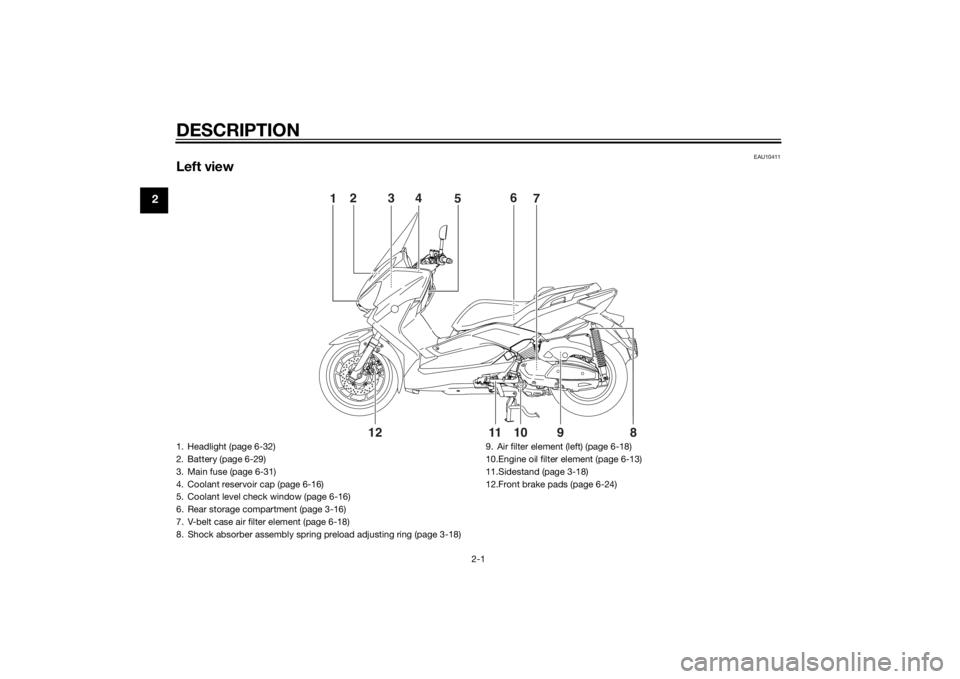
DESCRIPTION
2-1
2
EAU10411
Left view
1
5
8
2
4
3
7 6
9
10
11
12
1. Headlight (page 6-32)
2. Battery (page 6-29)
3. Main fuse (page 6-31)
4. Coolant reservoir cap (page 6-16)
5. Coolant level check window (page 6-16)
6. Rear storage compartment (page 3-16)
7. V-belt case air filter element (page 6-18)
8. Shock absorber assembly spring preload adjusting ring (page 3-18)9. Air filter element (left) (page 6-18)
10.Engine oil filter element (page 6-13)
11.Sidestand (page 3-18)
12.Front brake pads (page 6-24)U1SDE1E0.book Page 1 Monday, September 23, 2013 3:55 PM
Page 20 of 92
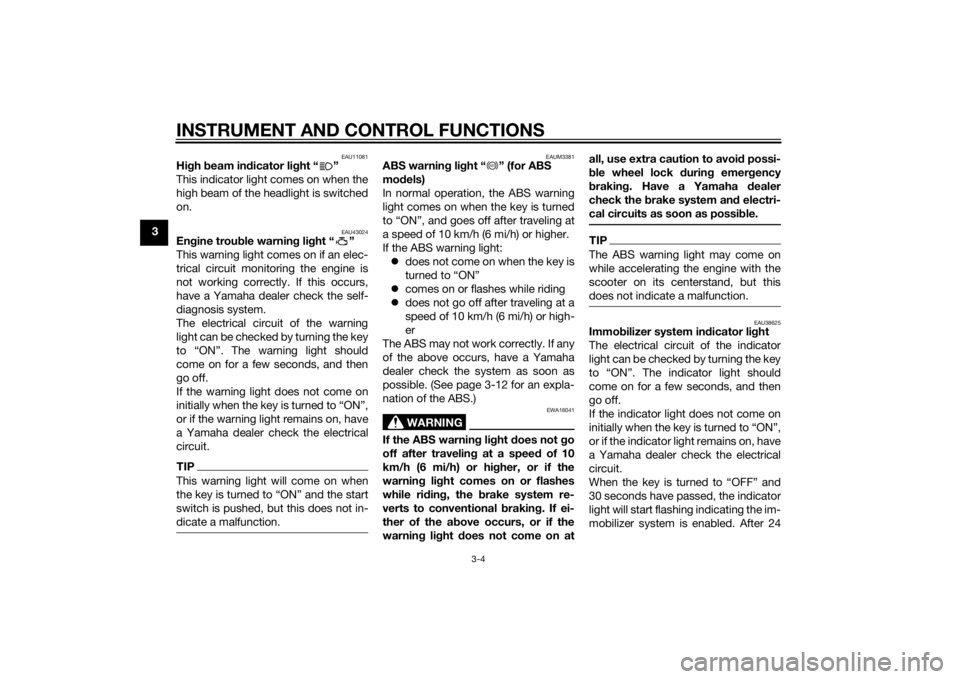
INSTRUMENT AND CONTROL FUNCTIONS
3-4
3
EAU11081
High beam indicator light “ ”
This indicator light comes on when the
high beam of the headlight is switched
on.
EAU43024
Engine trouble warning light “ ”
This warning light comes on if an elec-
trical circuit monitoring the engine is
not working correctly. If this occurs,
have a Yamaha dealer check the self-
diagnosis system.
The electrical circuit of the warning
light can be checked by turning the key
to “ON”. The warning light should
come on for a few seconds, and then
go off.
If the warning light does not come on
initially when the key is turned to “ON”,
or if the warning light remains on, have
a Yamaha dealer check the electrical
circuit.TIPThis warning light will come on when
switch is pushed, but this does not in-
dicate a malfunction.
EAUM3381
ABS warning light “ ” (for ABS
models)
In normal operation, the ABS warning
light comes on when the key is turned
to “ON”, and goes off after traveling at
a speed of 10 km/h (6 mi/h) or higher.
If the ABS warning light:
does not come on when the key is
turned to “ON”
comes on or flashes while riding
does not go off after traveling at a
speed of 10 km/h (6 mi/h) or high-
er
The ABS may not work correctly. If any
of the above occurs, have a Yamaha
dealer check the system as soon as
possible. (See page 3-12 for an expla-
nation of the ABS.)
WARNING
EWA16041
If the ABS warning light does not go
off after traveling at a speed of 10
km/h (6 mi/h) or higher, or if the
warning light comes on or flashes
while riding, the brake system re-
verts to conventional braking. If ei-
ther of the above occurs, or if the
warning light does not come on atall, use extra caution to avoid possi-
ble wheel lock during emergency
braking. Have a Yamaha dealer
check the brake system and electri-
cal circuits as soon as possible.
TIPThe ABS warning light may come on
while accelerating the engine with the
scooter on its centerstand, but this
does not indicate a malfunction.
EAU38625
Immobilizer system indicator light
The electrical circuit of the indicator
light can be checked by turning the key
to “ON”. The indicator light should
come on for a few seconds, and then
go off.
If the indicator light does not come on
initially when the key is turned to “ON”,
or if the indicator light remains on, have
a Yamaha dealer check the electrical
circuit.
When the key is turned to “OFF” and
30 seconds have passed, the indicator
light will start flashing indicating the im-
mobilizer system is enabled. After 24
ABS
U1SDE1E0.book Page 4 Monday, September 23, 2013 3:55 PM
Page 24 of 92
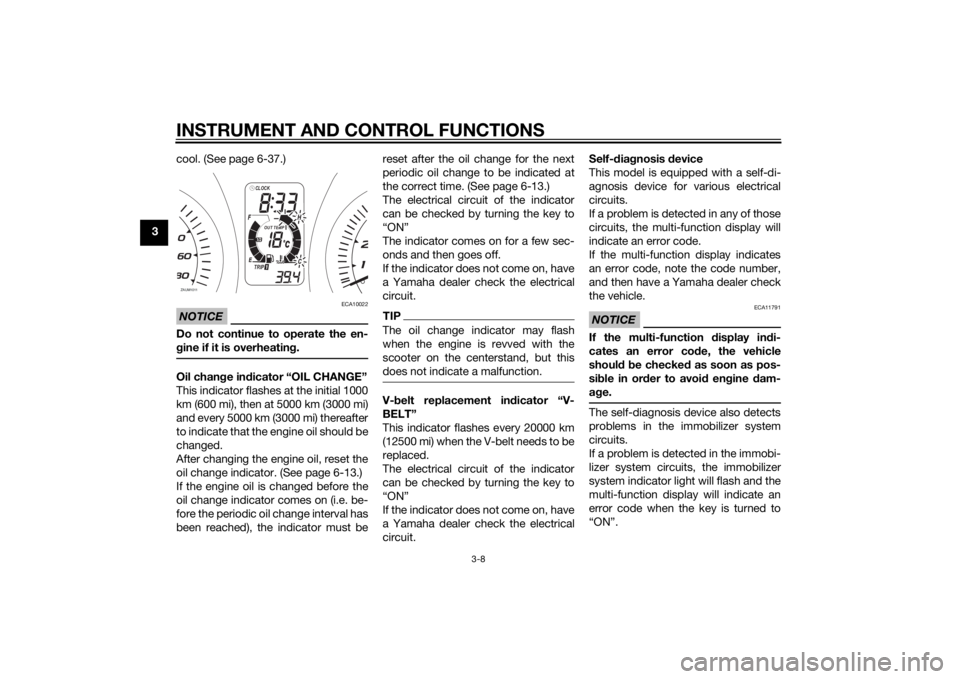
INSTRUMENT AND CONTROL FUNCTIONS
3-8
3cool. (See page 6-37.)
NOTICE
ECA10022
Do not continue to operate the en-
gine if it is overheating.Oil change indicator “OIL CHANGE”
This indicator flashes at the initial 1000
km (600 mi), then at 5000 km (3000 mi)
and every 5000 km (3000 mi) thereafter
to indicate that the engine oil should be
changed.
After changing the engine oil, reset the
oil change indicator. (See page 6-13.)
If the engine oil is changed before the
oil change indicator comes on (i.e. be-
fore the periodic oil change interval has
been reached), the indicator must bereset after the oil change for the next
periodic oil change to be indicated at
the correct time. (See page 6-13.)
The electrical circuit of the indicator
can be checked by turning the key to
“ON”
The indicator comes on for a few sec-
onds and then goes off.
If the indicator does not come on, have
a Yamaha dealer check the electrical
circuit.
TIPThe oil change indicator may flash
when the engine is revved with the
scooter on the centerstand, but this
does not indicate a malfunction.V-belt replacement indicator “V-
BELT”
This indicator flashes every 20000 km
(12500 mi) when the V-belt needs to be
replaced.
The electrical circuit of the indicator
can be checked by turning the key to
“ON”
If the indicator does not come on, have
a Yamaha dealer check the electrical
circuit.Self-diagnosis device
This model is equipped with a self-di-
agnosis device for various electrical
circuits.
If a problem is detected in any of those
circuits, the multi-function display will
indicate an error code.
If the multi-function display indicates
an error code, note the code number,
and then have a Yamaha dealer check
the vehicle.
NOTICE
ECA11791
If the multi-function display indi-
cates an error code, the vehicle
should be checked as soon as pos-
sible in order to avoid engine dam-
age.The self-diagnosis device also detects
problems in the immobilizer system
circuits.
If a problem is detected in the immobi-
lizer system circuits, the immobilizer
system indicator light will flash and the
multi-function display will indicate an
error code when the key is turned to
“ON”.
ZAUM1011
1/21/2CLOCKOUT TEMP
°C
TRIP1
U1SDE1E0.book Page 8 Monday, September 23, 2013 3:55 PM
Page 35 of 92

INSTRUMENT AND CONTROL FUNCTIONS
3-19
3
WARNING
EWA10242
The vehicle must not be ridden with
the sidestand down, or if the side-
stand cannot be properly moved up
(or does not stay up), otherwise the
sidestand could contact the ground
and distract the operator, resulting
in a possible loss of control.
Yamaha’s ignition circuit cut-off
system has been designed to assist
the operator in fulfilling the respon-
sibility of raising the sidestand be-
fore starting off. Therefore, check
this system regularly and have a
Yamaha dealer repair it if it does not
function properly.
EAU45053
Ignition circuit cut-off systemThe ignition circuit cut-off system
(comprising the sidestand switch and
brake light switches) has the following
functions.
It prevents starting when the side-
stand is up, but neither brake is
applied.
It prevents starting when either
brake is applied, but the sidestand
is still down.
It cuts the running engine when
the sidestand is moved down.
Periodically check the operation of the
ignition circuit cut-off system accord-
ing to the following procedure.
U1SDE1E0.book Page 19 Monday, September 23, 2013 3:55 PM
Page 36 of 92
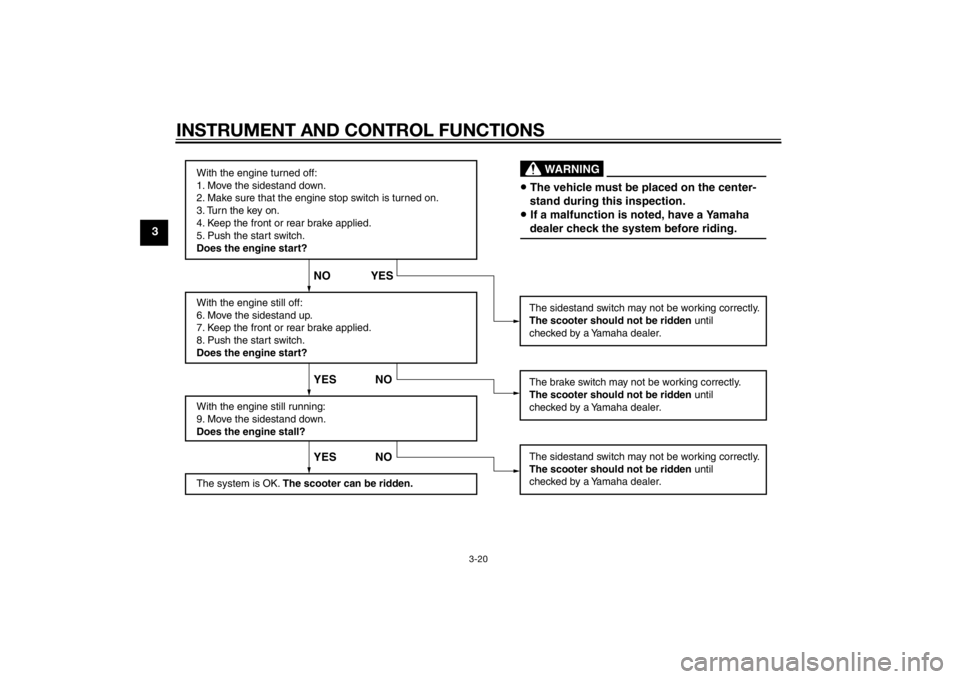
INSTRUMENT AND CONTROL FUNCTIONS
3-20
3
With the engine turned off:
1. Move the sidestand down.
2. Make sure that the engine stop switch is turned on.
3. Turn the key on.
4. Keep the front or rear brake applied.
5. Push the start switch.
Does the engine start?
With the engine still off:
6. Move the sidestand up.
7. Keep the front or rear brake applied.
8. Push the start switch.
Does the engine start?
With the engine still running:
9. Move the sidestand down.
Does the engine stall?
The system is OK. The scooter can be ridden.The sidestand switch may not be working correctly.
The scooter should not be ridden until
checked by a Yamaha dealer.
The sidestand switch may not be working correctly.
The scooter should not be ridden until
checked by a Yamaha dealer.
YES NO YES NO NO YES
The brake switch may not be working correctly.
The scooter should not be ridden until
checked by a Yamaha dealer.• The vehicle must be placed on the center-
stand during this inspection.• If a malfunction is noted, have a Yamaha
dealer check the system before riding.
WARNING
U1SDE1E0.book Page 20 Monday, September 23, 2013 3:55 PM
Page 37 of 92
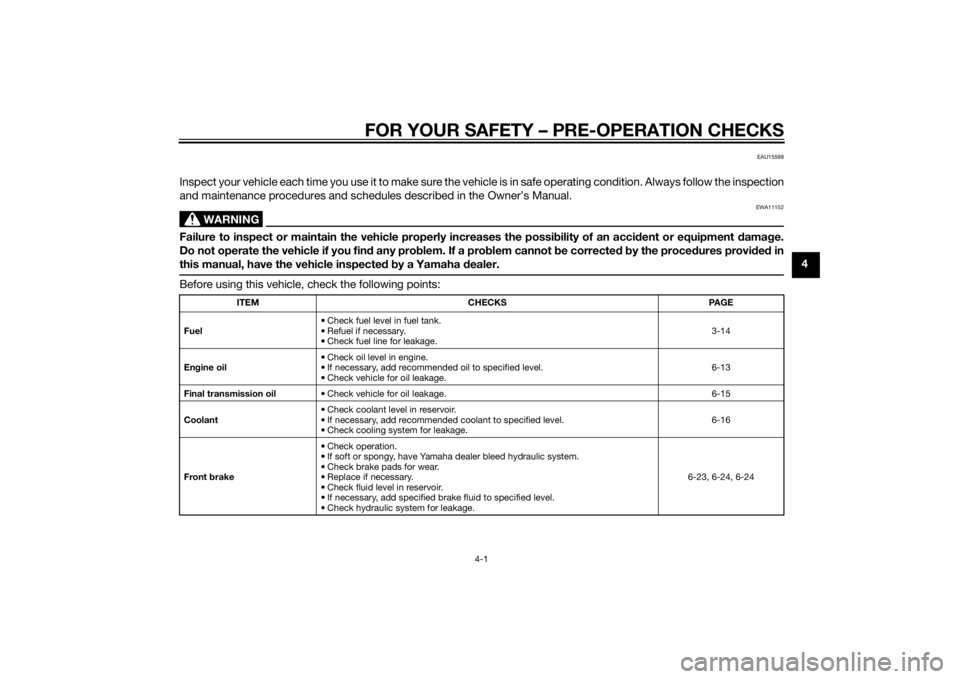
FOR YOUR SAFETY – PRE-OPERATION CHECKS
4-1
4
EAU15598
Inspect your vehicle each time you use it to make sure the vehicle is in safe operating condition. Always follow the inspection
and maintenance procedures and schedules described in the Owner’s Manual.
WARNING
EWA11152
Failure to inspect or maintain the vehicle properly increases the possibility of an accident or equipment damage.
Do not operate the vehicle if you find any problem. If a problem cannot be corrected by the procedures provided in
this manual, have the vehicle inspected by a Yamaha dealer.Before using this vehicle, check the following points:
ITEM CHECKS PAGE
Fuel• Check fuel level in fuel tank.
• Refuel if necessary.
• Check fuel line for leakage.3-14
Engine oil• Check oil level in engine.
• If necessary, add recommended oil to specified level.
• Check vehicle for oil leakage.6-13
Final transmission oil• Check vehicle for oil leakage. 6-15
Coolant• Check coolant level in reservoir.
• If necessary, add recommended coolant to specified level.
• Check cooling system for leakage.6-16
Front brake• Check operation.
• If soft or spongy, have Yamaha dealer bleed hydraulic system.
• Check brake pads for wear.
• Replace if necessary.
• Check fluid level in reservoir.
• If necessary, add specified brake fluid to specified level.
• Check hydraulic system for leakage.6-23, 6-24, 6-24
U1SDE1E0.book Page 1 Monday, September 23, 2013 3:55 PM
Page 40 of 92

OPERATION AND IMPORTANT RIDING POINTS
5-2
5
NOTICE
ECA15025
If a warning light, indicator light or
indicator does not go off, see pages
3-3, 3-6, 3-8, 3-8 or 3-8 for the corre-
sponding warning light, indicator
light or indicator circuit check.2. Close the throttle completely.
3. Start the engine by pushing the
start switch while applying the
front or rear brake.
If the engine does not start, re-
lease the start switch, wait a few
seconds, and then try again. Each
starting attempt should be as
short as possible to preserve thebattery. Do not crank the engine
more than 10 seconds on any one
attempt.
NOTICE
ECA11043
For maximum engine life, never ac-
celerate hard when the engine is
cold!
EAU45093
Starting off1. While pulling the rear brake lever
with your left hand and holding the
grab bar with your right hand,
push the scooter off the center-
stand.
2. Sit astride the seat, and then ad-
just the rear view mirrors.
3. Switch the turn signals on.
4. Check for oncoming traffic, and
then slowly turn the throttle grip
(on the right) in order to take off.
5. Switch the turn signals off.
1. Rear brake lever
2. Front brake lever
3. Start switch
1. Grab bar
U1SDE1E0.book Page 2 Monday, September 23, 2013 3:55 PM
Page 42 of 92
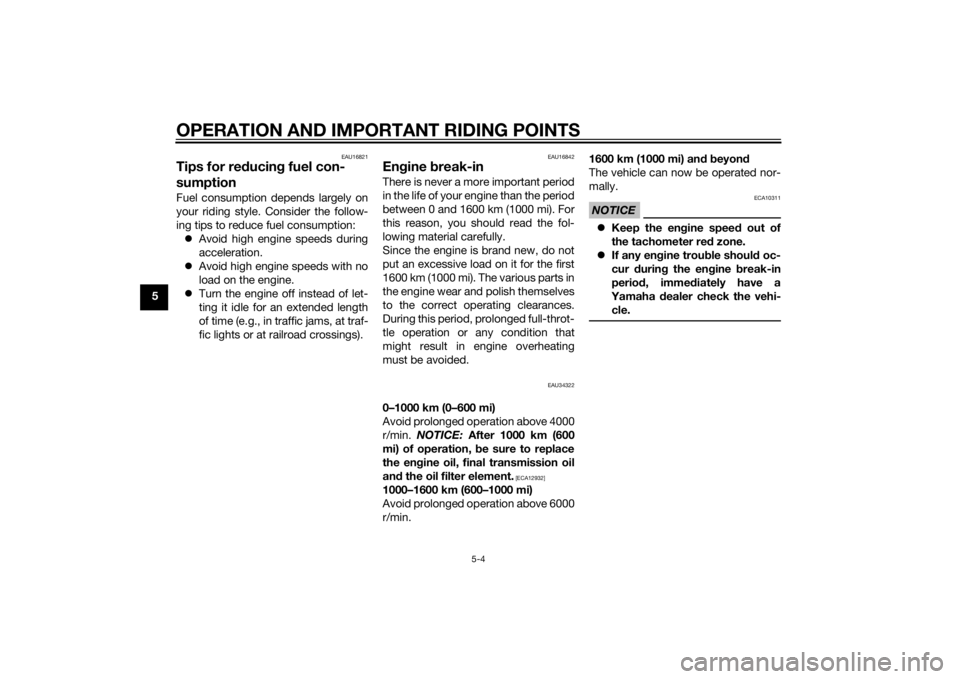
OPERATION AND IMPORTANT RIDING POINTS
5-4
5
EAU16821
Tips for reducing fuel con-
sumptionFuel consumption depends largely on
your riding style. Consider the follow-
ing tips to reduce fuel consumption:
Avoid high engine speeds during
acceleration.
Avoid high engine speeds with no
load on the engine.
Turn the engine off instead of let-
ting it idle for an extended length
of time (e.g., in traffic jams, at traf-
fic lights or at railroad crossings).
EAU16842
Engine break-inThere is never a more important period
in the life of your engine than the period
between 0 and 1600 km (1000 mi). For
this reason, you should read the fol-
lowing material carefully.
Since the engine is brand new, do not
put an excessive load on it for the first
1600 km (1000 mi). The various parts in
the engine wear and polish themselves
to the correct operating clearances.
During this period, prolonged full-throt-
tle operation or any condition that
might result in engine overheating
must be avoided.
EAU34322
0–1000 km (0–600 mi)
Avoid prolonged operation above 4000
r/min. NOTICE: After 1000 km (600
mi) of operation, be sure to replace
the engine oil, final transmission oil
and the oil filter element.
[ECA12932]
1000–1600 km (600–1000 mi)
Avoid prolonged operation above 6000
r/min.1600 km (1000 mi) and beyond
The vehicle can now be operated nor-
mally.
NOTICE
ECA10311
Keep the engine speed out of
the tachometer red zone.
If any engine trouble should oc-
cur during the engine break-in
period, immediately have a
Yamaha dealer check the vehi-
cle.
U1SDE1E0.book Page 4 Monday, September 23, 2013 3:55 PM